THE HOUSTON HURRICANE POLLUTION-SNIFFING NASA FLIGHT THAT NEVER TOOK OFF 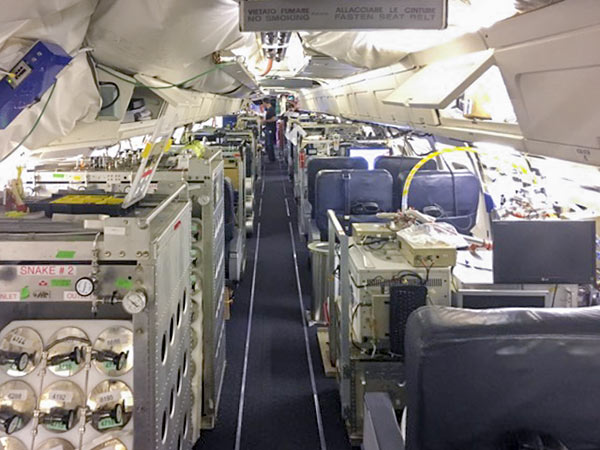 A week and a half after Hurricane Harvey hit Houston, as damage to smokestacks, pipelines, and chemical storage tanks were still being assessed, flooded Superfund sites went unmonitored, and clouds of benzene and other chemicals assembled in the skies over the city, the crew of a California-based airborne NASA chemical lab offered to help figure out the state of affairs — by diverting its specially equipped DC-8 from a planned trip to Oklahoma to take measurements in Houston instead. But EPA and TCEQ officials vehemently passed on the offer. An email response from TCEQ air toxicologist Michael Honeycutt noted that “state data showed no sign for concern,” report the L.A. Times‘s Susanne Rust and Louis Sahagun. “We don’t think your data would be useful for source identification while industry continues to restart their operations,” wrote Honeycutt, who the following month was appointed to head the EPA’s Science Advisory Board by President Trump. David Gray, the EPA official in charge of the Harvey emergency response, agreed. Citing emails from Texas officials “stating unambiguously that they do not want NASA to use the DC-8 for any data acquisition,” Michael Freilich, the director of NASA’s Earth Sciences division, called off the mission. [L.A. Times] Photo of Atmospheric Tomography Mission DC-8 interior, September 2017: NASA
A week and a half after Hurricane Harvey hit Houston, as damage to smokestacks, pipelines, and chemical storage tanks were still being assessed, flooded Superfund sites went unmonitored, and clouds of benzene and other chemicals assembled in the skies over the city, the crew of a California-based airborne NASA chemical lab offered to help figure out the state of affairs — by diverting its specially equipped DC-8 from a planned trip to Oklahoma to take measurements in Houston instead. But EPA and TCEQ officials vehemently passed on the offer. An email response from TCEQ air toxicologist Michael Honeycutt noted that “state data showed no sign for concern,” report the L.A. Times‘s Susanne Rust and Louis Sahagun. “We don’t think your data would be useful for source identification while industry continues to restart their operations,” wrote Honeycutt, who the following month was appointed to head the EPA’s Science Advisory Board by President Trump. David Gray, the EPA official in charge of the Harvey emergency response, agreed. Citing emails from Texas officials “stating unambiguously that they do not want NASA to use the DC-8 for any data acquisition,” Michael Freilich, the director of NASA’s Earth Sciences division, called off the mission. [L.A. Times] Photo of Atmospheric Tomography Mission DC-8 interior, September 2017: NASA
Tag: NASA
NASA TO STUDY HOW LOUD SUPERSONIC JET GETS BY FLYING OVER GALVESTON 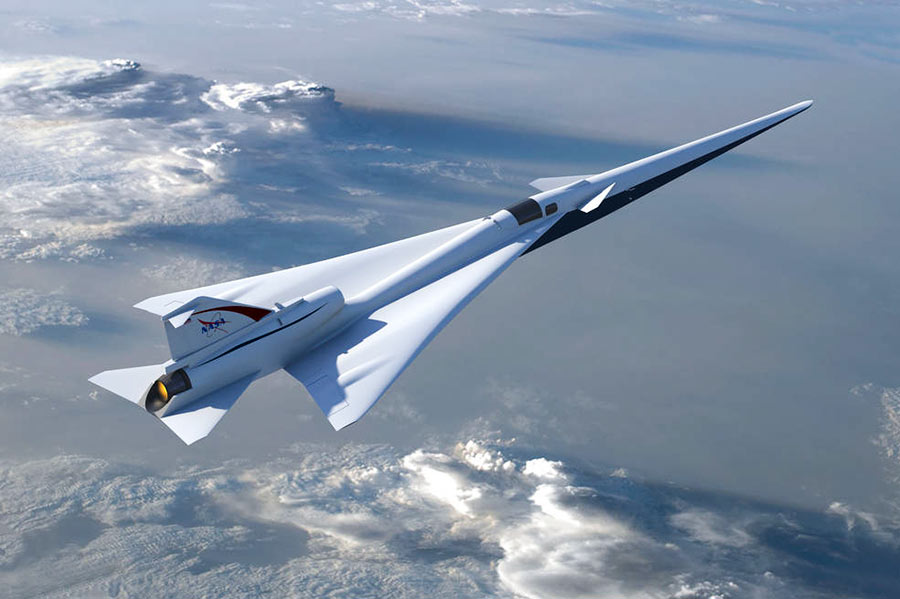 Lockheed Martin is pitching its planned supersonic passenger plane as the quietest yet — despite its top speed of 940 mph. The company says a prototype will be ready within the next few years. But NASA won’t wait that long to find out how loud it’ll be: “the government agency will use an F/A-18 Hornet aircraft to replicate the softer sonic boom and measure how receptive Galvestonians will be,” reports the Chronicle‘s Andrea Rumbaugh. After lifting off from Ellington Airport, the plane will dive down at a 53-degree angle off the Galveston coast, breaking the sound barrier as it does. “Most of that sound will go toward the water,” writes Rumbaugh. But when it pulls up, “some of the sound will travel toward Galveston. By the time it reaches the island, it will be at the sound level expected from NASA’s X-plane.” Five hundred chosen residents and a handful of sound monitors will listen up for 10 non-consecutive days in November and provide feedback on the noise level — which NASA’s project manager says shouldn’t be that bad: “If a traditional sonic boom is hearing a thunderstorm directly overhead,” he explains “then the new reduced sonic boom will be like hearing a storm rumble far in the distance.” [Houston Chronicle ($)] Rendering of Low Boom Flight Demonstration X-plane: NASA
Lockheed Martin is pitching its planned supersonic passenger plane as the quietest yet — despite its top speed of 940 mph. The company says a prototype will be ready within the next few years. But NASA won’t wait that long to find out how loud it’ll be: “the government agency will use an F/A-18 Hornet aircraft to replicate the softer sonic boom and measure how receptive Galvestonians will be,” reports the Chronicle‘s Andrea Rumbaugh. After lifting off from Ellington Airport, the plane will dive down at a 53-degree angle off the Galveston coast, breaking the sound barrier as it does. “Most of that sound will go toward the water,” writes Rumbaugh. But when it pulls up, “some of the sound will travel toward Galveston. By the time it reaches the island, it will be at the sound level expected from NASA’s X-plane.” Five hundred chosen residents and a handful of sound monitors will listen up for 10 non-consecutive days in November and provide feedback on the noise level — which NASA’s project manager says shouldn’t be that bad: “If a traditional sonic boom is hearing a thunderstorm directly overhead,” he explains “then the new reduced sonic boom will be like hearing a storm rumble far in the distance.” [Houston Chronicle ($)] Rendering of Low Boom Flight Demonstration X-plane: NASA
COMMENT OF THE DAY: Y’ALL NOT TALKING ABOUT THAT DUCT TAPE SOLUTION HOUSTON CAME UP WITH TO FIX THAT PROBLEM WE HAD 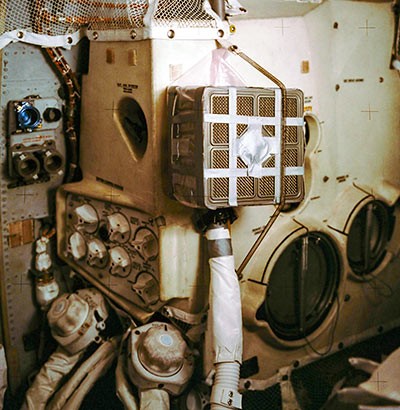 “‘Problem solved, crisis ended, astronauts saved,’ should be the answer the world should know. ‘Houston’ — actually JSC — solved the problem, saving the astronauts on Apollo 13.” [Blake, commenting on Taking on the ‘Houston, We Have a Problem’ Problem] Photo of device installed in-flight on Apollo 13 using duct tape, maps, and other materials on hand: NASA
“‘Problem solved, crisis ended, astronauts saved,’ should be the answer the world should know. ‘Houston’ — actually JSC — solved the problem, saving the astronauts on Apollo 13.” [Blake, commenting on Taking on the ‘Houston, We Have a Problem’ Problem] Photo of device installed in-flight on Apollo 13 using duct tape, maps, and other materials on hand: NASA
TAKING ON THE ‘HOUSTON, WE HAVE A PROBLEM’ PROBLEM 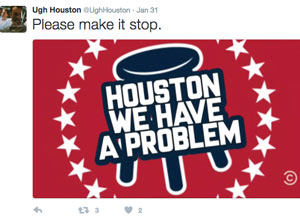 What can a little minor public shaming do in the face of a groundswell of clichéd space-themed Houston references from reporters and observers around the world (and the occasional newscaster from within)? Just in time to chronicle and reflect a seeming barrage of “Gee, no one’s ever repeated this before” references to Houston — as it emerged in the national spotlight in advance of yesterday’s Super Bowl — a Twitter account going by the handle Ugh Houston, created last month, set about to highlight, ridicule, and otherwise express disappointment toward any and all variations on the theme of  “Houston, we have a problem.” (The betting circuits even had 5-to-2 odds on whether the tagline, an alteration of the original quotation popularized by the 1995 movie about the Apollo 13 mission, would make an appearance in the Super Bowl broadcast,
What can a little minor public shaming do in the face of a groundswell of clichéd space-themed Houston references from reporters and observers around the world (and the occasional newscaster from within)? Just in time to chronicle and reflect a seeming barrage of “Gee, no one’s ever repeated this before” references to Houston — as it emerged in the national spotlight in advance of yesterday’s Super Bowl — a Twitter account going by the handle Ugh Houston, created last month, set about to highlight, ridicule, and otherwise express disappointment toward any and all variations on the theme of  “Houston, we have a problem.” (The betting circuits even had 5-to-2 odds on whether the tagline, an alteration of the original quotation popularized by the 1995 movie about the Apollo 13 mission, would make an appearance in the Super Bowl broadcast, though ultimately, it appears, it didn’t. and it did.) Other phrases targeted by the account include references to landing eagles and launching anything without an actual rocket engine. Here’s the big question, then, waged in harrumph-y asides, worldwide: Should or shouldn’t Houston embrace its popular association with extreme difficulty? Image: Ugh Houston Twitter account
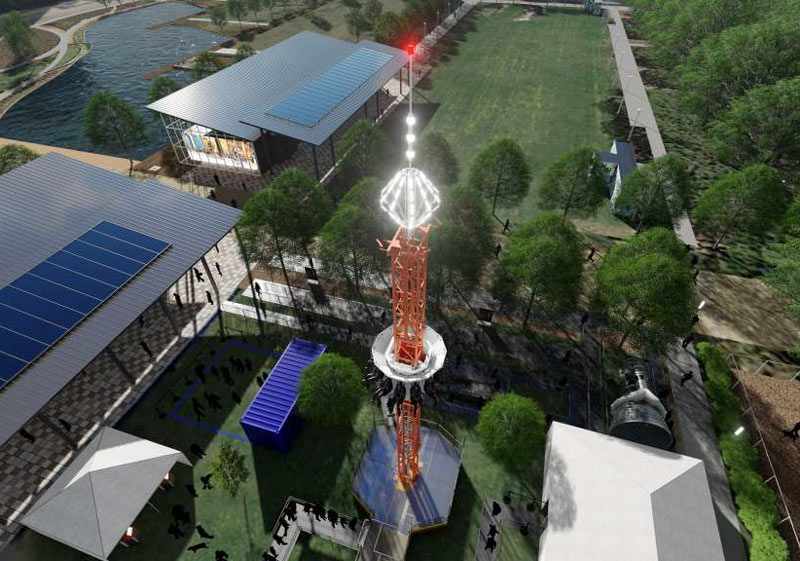
This week’s SpaceCom expo at the prettied-up George R. Brown Convention Center included a preview of some more down-to-earth plans for the immediate neighborhood — including the NASA-themed drop tower Mars mission ride to be installed for Super Bowl visitors at Discovery Green across the street. The ride, called Future Flight, will include virtual reality goggles; the rest of the setup will include a chance to try out the goggles for people who like virtual reality but don’t want to take the plunge, as well as some exhibits of next-gen space hardware  and some kid-geared activities.
The ride’ll be free — if you can get a spot. Chris Baldwin points out that about a million people are expected to show up at the pre-Super Bowl festival planned for the week before the game, but timeslots on the ride will be limited to a few thousand per day between January 28 and February 5 (and the details on how to get a spot aren’t out yet).
The burnt-orange scaffolding of the drop tower roughly matches the color scheme for the latest long-haul rocket setup NASA is working on:
NATIONAL HISTORIC PRESERVATIONISTS TO GATHER IN HOUSTON, GAWK AT ASTRODOME 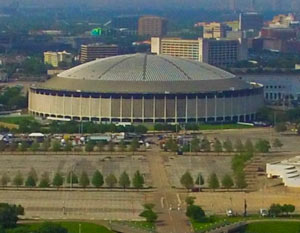 The National Trust for Historic Preservation — that’d be the folks that coined the ‘orgy of irrational destruction’ line picked up by Save the Bungalows a few years back — is holding its annual conference in Houston for the first time, starting next Tuesday. Current president Stephanie Meeks cites the city’s “compelling preservation story,” amid a regional lack of preservation-minded rules and regulations, as a reason for picking the city. Planned field trip locales include the Astrodome (currently getting ready for that basement parking garage remodel), as well as Mission Control, the artsifying warehouses and industrial facilities around Washington Ave., and a handful of Galveston historic districts. Also on the docket: the debut of the organization’s Atlas of ReUrbanism (a digital collection of built environment data aimed public officials, reporters, and other city data scavengers), for which Houston is one of 5 starter cities. Would-be attendees can catch some conference sessions next Tuesday through Friday in the neighborhood of the newly-game-faced George R. Brown Convention Center; those who don’t want to make the trip downtown can watch some sessions at home. [Previously on Swamplot] Photo of Astrodome: Russell Hancock via Swamplot Flickr Pool
The National Trust for Historic Preservation — that’d be the folks that coined the ‘orgy of irrational destruction’ line picked up by Save the Bungalows a few years back — is holding its annual conference in Houston for the first time, starting next Tuesday. Current president Stephanie Meeks cites the city’s “compelling preservation story,” amid a regional lack of preservation-minded rules and regulations, as a reason for picking the city. Planned field trip locales include the Astrodome (currently getting ready for that basement parking garage remodel), as well as Mission Control, the artsifying warehouses and industrial facilities around Washington Ave., and a handful of Galveston historic districts. Also on the docket: the debut of the organization’s Atlas of ReUrbanism (a digital collection of built environment data aimed public officials, reporters, and other city data scavengers), for which Houston is one of 5 starter cities. Would-be attendees can catch some conference sessions next Tuesday through Friday in the neighborhood of the newly-game-faced George R. Brown Convention Center; those who don’t want to make the trip downtown can watch some sessions at home. [Previously on Swamplot] Photo of Astrodome: Russell Hancock via Swamplot Flickr Pool
Sure, drone footage is great. But how often do you get to see 3 flying laboratories survey the breadth of Houston’s sprawl from this high up?
The trio of WB-57s shown surveying a hazy Houston in the video above are based at Ellington Field. The fleet is part of NASA’s WB-57 High Altitude Research Program, which regularly conducts scientific research and testing. Among its missions: mapping, collection of cosmic dust, support of rocket launches, and flights over hurricanes, including recent storms Joaquin and Patricia. Eerie faded-Emerald-City scenes of Downtown, the Galleria, the Med Center, and other vertical standouts unfold beneath the wingtips. The flight, which took place before Thanksgiving (but for which footage was only posted to YouTube this week) marks the first time since the early 1970s that 3 WB-57s have flown together.
Video: Johnson Space Center via Eric Berger
HOUSTON’S WAREHOUSED ROCKETSHIP 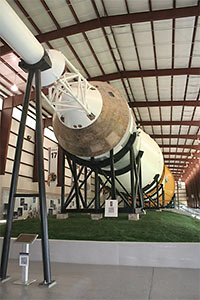 Comparing it to displays of Saturn rockets in Florida and Alabama, space historian Dwayne Day finds Space Center Houston’s model of the Apollo program leftover parked in a Johnson Space Center shed structure and looking somewhat forlorn: “. . . the building containing the Saturn V is starting to deteriorate. Interior insulation is starting to crack and peel, showing considerable degradation from my last visit a year ago. This simply reinforces the impression that the Saturn V is being stored in a big garage. Houston has had the Saturn V for decades. It has housed it indoors for almost seven years, and yet the city has not improved the presentation or shown any indication that it intends to display the Saturn V with any of the affection and intelligence that the Kennedy and Huntsville communities have given to their Saturn Vs. If you look at what Houston has done it is hard not to wonder if they would have treated a shuttle orbiter with the same indifference.” [Space Review; previously on Swamplot] Photo: Dwayne Day
Comparing it to displays of Saturn rockets in Florida and Alabama, space historian Dwayne Day finds Space Center Houston’s model of the Apollo program leftover parked in a Johnson Space Center shed structure and looking somewhat forlorn: “. . . the building containing the Saturn V is starting to deteriorate. Interior insulation is starting to crack and peel, showing considerable degradation from my last visit a year ago. This simply reinforces the impression that the Saturn V is being stored in a big garage. Houston has had the Saturn V for decades. It has housed it indoors for almost seven years, and yet the city has not improved the presentation or shown any indication that it intends to display the Saturn V with any of the affection and intelligence that the Kennedy and Huntsville communities have given to their Saturn Vs. If you look at what Houston has done it is hard not to wonder if they would have treated a shuttle orbiter with the same indifference.” [Space Review; previously on Swamplot] Photo: Dwayne Day
COMMENT OF THE DAY: JUST TO DRAG A SHUTTLE MOCKUP INTO HOUSTON “. . . I contacted the JSC’s PAO Office and found out that it was originally due here on March 10th but an area from the channel to JSC’s dock would have to be dredged in order to accommodate the tug pushing the barge. Current estimates have pushed the delivery time to some time in July. . . . I feel that the mock-up coming to JSC is a ray of hope on an otherwise bleak future. . . .” [Neal_K, commenting on Space Center Houston Getting KSC Space Shuttle Mockup Hand-Me-Down, Compartment Trainer, New Building]
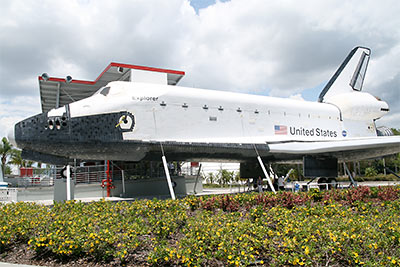
Houston may have missed out on its opportunity to play host to one of the 4 retired orbiters doled out recently by NASA. But it will end up with a space-shuttle-related attraction that jibes well with the Johnson Space Center’s longtime role as a practice and simulation site for training astronauts. Space news website CollectSpace is reporting that Space Center Houston will soon receive the Space Shuttle Explorer, a full-size orbiter mockup currently on display at the Kennedy Space Center Visitor Complex in Florida.
One advantage of the Explorer over the 4 orbiters Houstonians wanted but couldn’t get (besides not having any layers of space dust to clean off): Visitors will be able to walk through it.
A ROCKETSHIP RELAUNCH FOR THE JOHNSON SPACE CENTER? 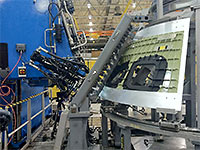 Construction of the new Orion Multi-Purpose Crew Vehicle, the first new NASA spacecraft built for manned orbit since 1991, began earlier this week — in New Orleans (photo). And final assembly will take place in Florida. But a “senior administration official” tells space-beat reporter Todd Halvorson that the new 30-story tall Space Launch System for Orion that NASA is announcing today — with the strong support of Sen. Kay Bailey Hutchison — will provide a “stable future” for Houston’s Johnson Space Center and 3 other human-space-flight facilities around the country. [Florida Today; NASA] Photo: NASA
Construction of the new Orion Multi-Purpose Crew Vehicle, the first new NASA spacecraft built for manned orbit since 1991, began earlier this week — in New Orleans (photo). And final assembly will take place in Florida. But a “senior administration official” tells space-beat reporter Todd Halvorson that the new 30-story tall Space Launch System for Orion that NASA is announcing today — with the strong support of Sen. Kay Bailey Hutchison — will provide a “stable future” for Houston’s Johnson Space Center and 3 other human-space-flight facilities around the country. [Florida Today; NASA] Photo: NASA
JUST ANOTHER HOUSTON HOMEBUILDER “But there are plenty of challenges to overcome first. To camp on the moon, astronauts need to be shielded from solar radiation. In a waterless environment every drop of H2O, including sweat and urine, must be recycled and purified. NASA engineers are sorting through dozens of possible models for the lunar outpost—from horizontal, aluminum cylinders to inflatable structures that are essentially giant, Kevlar-reinforced balloons.” [Smithsonian]

CNET’s Daniel Terdiman takes a tour of the Johnson Space Center and comes back with some photos of equipment and facilities being developed for Constellation, the back-to-the-moon project scheduled to begin launching in 2013. (The Space Shuttle program will be phased out by 2010.)
For those of us interested in the latest in Houston interiors technology, Terdiman includes photos of a mockup of the Orion Crew Exploration Vehicle, meant to take the next generation of astronauts to the moon and beyond. Is that a strip of velcro on the wall on the right? Cool!
Doesn’t look so exciting to you? Hey, they’ve got 5 years to work on it!
After the jump: The Orion capsule mockup from the outside, plus the new 12-wheeler parked outside!

